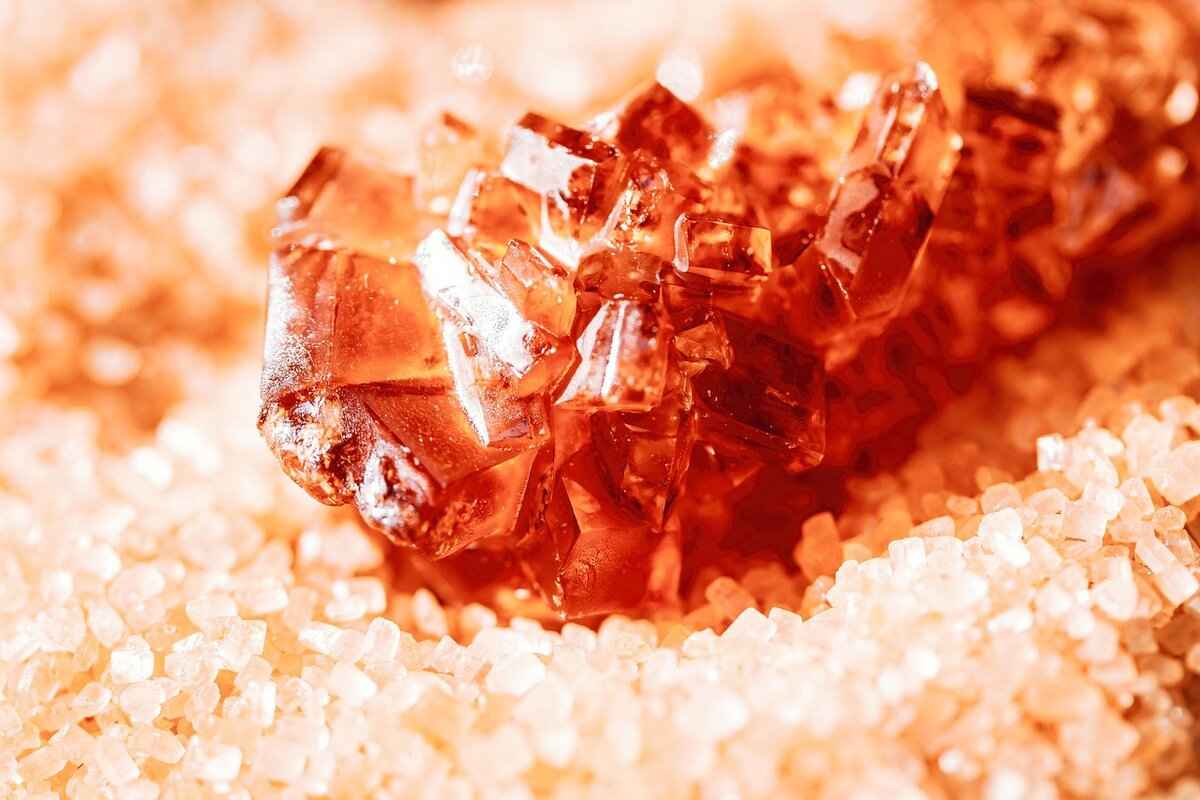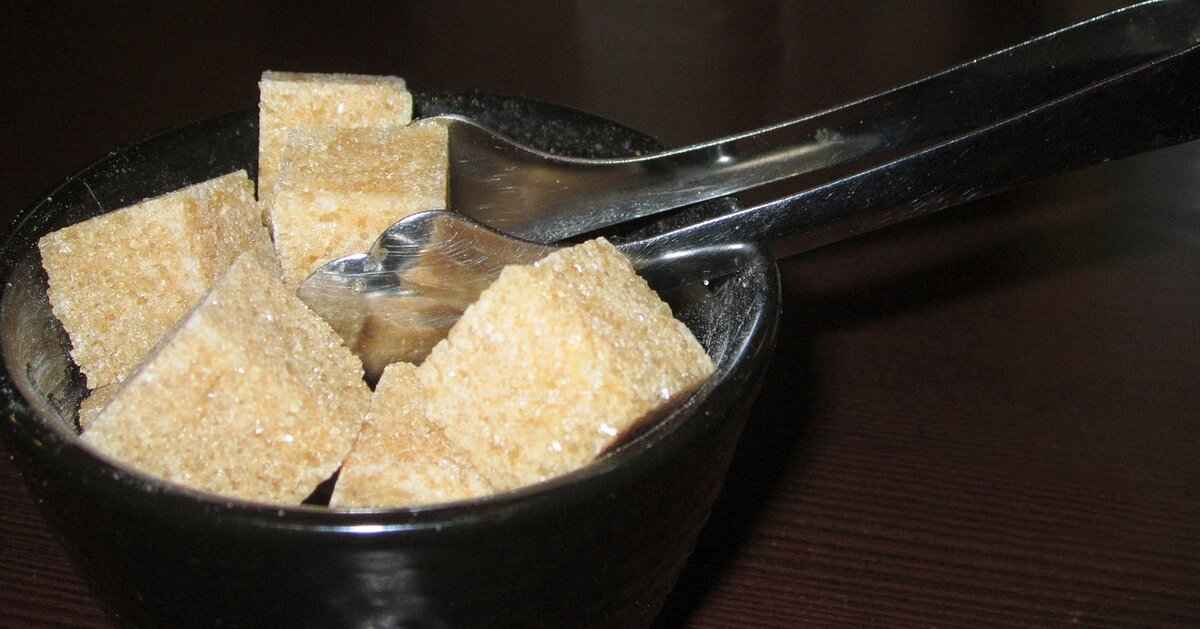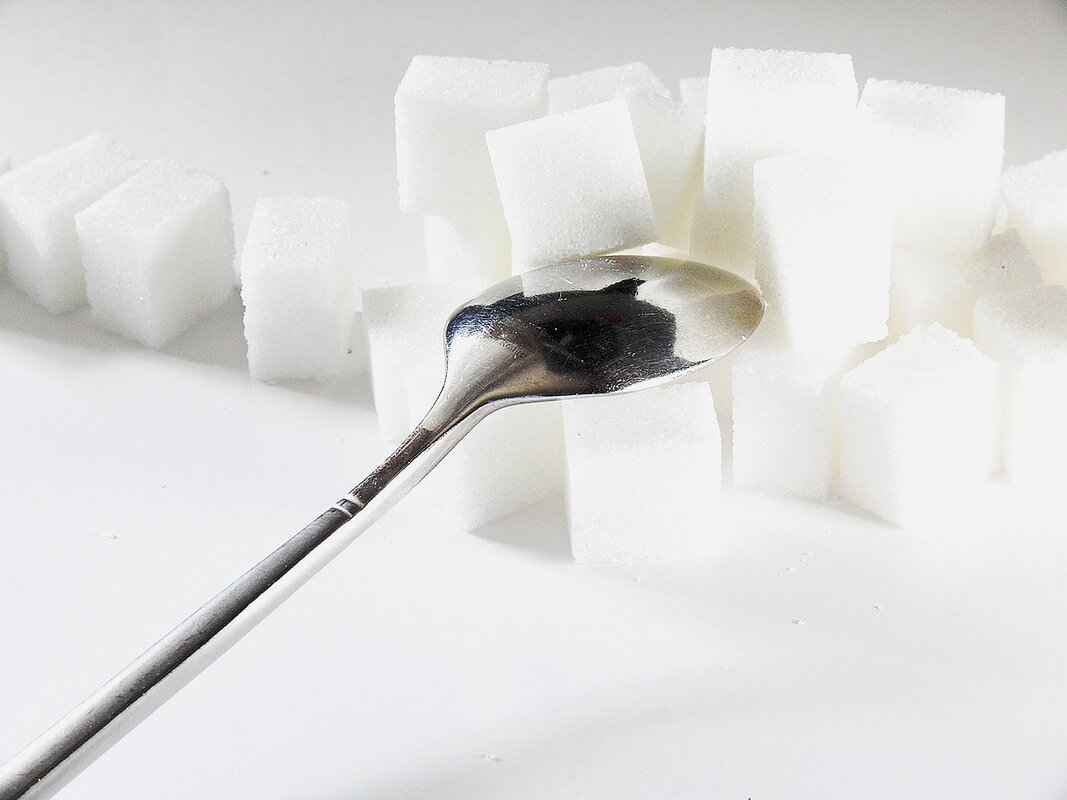This article explores the differences between rock sugar and regular sugar, focusing on their roles in Chinese braising. We will examine flavor profiles, culinary applications, health impacts, and more.
Rock sugar, known as “rock candy” in some regions, is a traditional sweetener in Chinese cuisine. It is produced through the crystallization of sugar syrup, resulting in large, irregular crystals that are less sweet than regular sugar. The production process involves boiling sugar and water until it reaches a specific temperature, then allowing it to cool and crystallize. This method not only creates its unique texture but also preserves some of the natural flavors found in the sugarcane.
Regular sugar, or granulated sugar, is the most common sweetener found in Western cooking. It is highly processed and has a fine texture, making it dissolve quickly in liquids. In contrast, rock sugar has a coarser texture and dissolves slowly, which can enhance the flavors of dishes over a longer cooking period.
Rock sugar offers a subtle sweetness that allows the natural flavors of ingredients to shine through. Unlike regular sugar, which can overpower a dish, rock sugar enhances the overall taste, making it ideal for braises and desserts. Its unique flavor profile complements savory ingredients, adding depth and complexity to traditional Chinese recipes.
The preference for rock sugar in Chinese culinary traditions stems from its ability to dissolve slowly, imparting a unique flavor throughout the cooking process. This gradual melting ensures a balanced sweetness that enhances the dish’s overall profile, making it a favored choice for braising meats and preparing sweet soups.
While rock sugar and regular sugar can sometimes be interchanged, the results may vary significantly. Substituting regular sugar for rock sugar can lead to a more intense sweetness and potentially alter the dish’s texture and flavor. It is essential to consider the specific recipe and desired outcome when making substitutions.
Rock sugar is often perceived as a healthier alternative to regular sugar due to its less processed nature. It contains trace minerals that are absent in regular sugar. However, it is still a form of sugar and should be consumed in moderation. Understanding the nutritional aspects and potential benefits of incorporating rock sugar into diets is crucial for health-conscious individuals.
Understanding the right moments to use rock sugar can elevate your braising techniques. It is particularly effective in dishes that require long cooking times, such as braised meats and stews. The slow dissolving nature of rock sugar allows for a gradual infusion of sweetness, enhancing the dish’s flavor.
- Braised Pork Belly
- Red-Cooked Chicken
- Sweet and Sour Dishes
- Chinese Herbal Soups
Incorporating rock sugar requires specific techniques for optimal results. It is best added early in the cooking process to allow it to dissolve and blend with other ingredients. For recipes that involve simmering, adding rock sugar at the beginning can enhance the overall flavor profile.
Despite its popularity, there are several misconceptions surrounding rock sugar. Many believe it is significantly healthier than regular sugar, which can lead to overconsumption. It is important to clarify that while it has some advantages, it still contributes to overall sugar intake.
Selecting high-quality rock sugar can impact your culinary results. Look for crystals that are clear and free from impurities. The best rock sugar should have a uniform size and a pleasant, mild aroma.
Not all rock sugar is created equal; various types exist with distinct properties. Some common varieties include white rock sugar, which is refined, and brown rock sugar, which retains more molasses and has a richer flavor. Each type serves different culinary purposes, so it’s essential to choose the right one for your recipe.

What is Rock Sugar and How is it Made?
Rock sugar, also known as rock candy, is a unique ingredient that plays a pivotal role in Chinese cuisine. Its distinctive crystal form not only adds a visual appeal but also a subtle sweetness that enhances various dishes. This article will explore the production process, characteristics, and culinary applications of rock sugar, providing a comprehensive understanding of this essential ingredient.
Rock sugar is produced through a crystallization process that involves the slow evaporation of sugar syrup. The process begins with dissolving sugar in water to create a concentrated syrup. This syrup is then heated until it reaches a specific temperature, allowing the sugar to crystallize as it cools. The resulting crystals are larger and more transparent than regular sugar, giving rock sugar its unique appearance.
Traditionally, rock sugar is made from cane sugar or beet sugar, and it is often used in Chinese herbal medicine due to its perceived health benefits. The production of rock sugar can take several days, as the crystals form slowly, ensuring a high-quality product.
- Appearance: Rock sugar typically appears as large, transparent crystals that sparkle in the light.
- Flavor: It has a milder sweetness compared to regular sugar, making it ideal for enhancing the natural flavors of dishes without overpowering them.
- Solubility: Rock sugar dissolves slowly, which allows for a gradual release of sweetness in cooking, particularly in braises and soups.
Rock sugar is a common ingredient in various traditional Chinese dishes, particularly in braised meats, soups, and desserts. Its ability to dissolve slowly makes it perfect for dishes that require long cooking times, as it imparts a subtle sweetness and depth of flavor.
Some popular dishes that benefit from the use of rock sugar include:
- Red Braised Pork: The slow cooking process allows the rock sugar to melt and caramelize, enriching the flavor of the meat.
- Sweet Soups: Rock sugar is often added to sweet soups, such as mung bean soup or red bean soup, to enhance their natural sweetness.
- Herbal Teas: In traditional Chinese medicine, rock sugar is frequently used to sweeten herbal teas, providing both flavor and health benefits.
While regular sugar is widely used in Western cooking, rock sugar offers unique advantages in Asian cuisines. Its slow dissolution allows for a more controlled sweetness, and its less processed nature is often perceived as a healthier alternative. Additionally, rock sugar can enhance the overall flavor profile of dishes, making it a preferred choice among chefs and home cooks alike.
In conclusion, rock sugar is not just a sweetener but a vital ingredient that contributes to the complexity and depth of flavor in many traditional Chinese dishes. Understanding its production, characteristics, and culinary uses can help elevate your cooking and appreciation for this unique ingredient.

How Does Regular Sugar Compare to Rock Sugar?
When it comes to sweetening our favorite dishes, the choice between regular sugar and rock sugar can significantly influence the final flavor and texture. While both sugars serve the primary purpose of adding sweetness, their chemical composition, texture, and sweetness levels set them apart in the culinary world.
Regular sugar, also known as sucrose, is derived from sugar cane or sugar beets and consists of glucose and fructose molecules. This sugar dissolves quickly and is commonly used in baking and cooking in Western cuisines. On the other hand, rock sugar, or rock candy, is a more crystalline form of sugar that is often produced through the crystallization of sugar syrup. It contains larger crystals and is typically less processed than regular sugar, which can affect its flavor profile.
The texture of these sugars plays a crucial role in their culinary applications. Regular sugar has a fine, granulated texture that makes it easy to incorporate into recipes. In contrast, rock sugar is characterized by its large, chunky crystals. This unique texture allows rock sugar to dissolve slowly, making it ideal for braising and slow-cooked dishes, where a gradual release of sweetness is preferred.
In terms of sweetness, regular sugar is generally sweeter than rock sugar due to its higher concentration of sucrose. This means that when substituting rock sugar for regular sugar, one may need to use a larger quantity to achieve the same level of sweetness. However, the subtle sweetness of rock sugar can enhance the natural flavors of ingredients, particularly in Chinese braises and desserts.
- Regular Sugar: Ideal for baking, sweetening beverages, and making sauces.
- Rock Sugar: Perfect for braising meats, making traditional desserts, and enhancing the flavor of soups.
While both sugars provide energy, their health implications can vary. Regular sugar is often associated with various health concerns, including weight gain and increased risk of diabetes when consumed in excess. Rock sugar, being less processed, is sometimes viewed as a healthier alternative; however, it is essential to consume it in moderation. The perception of rock sugar as a healthier option may stem from its traditional uses in herbal teas and remedies.
In summary, while regular sugar and rock sugar may seem interchangeable, their differences in composition, texture, and sweetness levels influence their applications in cooking. Understanding these distinctions can help you make informed choices in the kitchen, enhancing your culinary creations with the right type of sugar for each dish.
What are the Flavor Profiles of Rock Sugar?
Rock sugar is a fascinating ingredient that plays a pivotal role in enhancing the flavors of various dishes, particularly in Chinese cuisine. Unlike regular sugar, which often dominates the palate with its overt sweetness, rock sugar offers a more subtle sweetness that complements rather than overwhelms. This quality makes it an ideal choice for both savory and sweet dishes, allowing the natural flavors of the ingredients to shine through.
When used in cooking, rock sugar dissolves slowly, releasing its sweetness gradually. This slow dissolution allows it to integrate seamlessly with other flavors, creating a harmonious balance in dishes. For instance, in braises, rock sugar enhances the richness of meats and the complexity of spices without masking their inherent flavors. Its unique ability to mellow spicy or bitter notes makes it a sought-after ingredient in traditional recipes.
In desserts, rock sugar serves a dual purpose: it sweetens while also contributing to the overall texture and mouthfeel of the dish. For example, when preparing Chinese rice pudding or sweet soups, rock sugar provides a gentle sweetness that complements the creamy elements, resulting in a well-rounded dessert experience. Additionally, its crystalline structure can add a delightful crunch when used as a topping.
- Meats: Rock sugar pairs beautifully with meats such as pork and chicken, especially when braised with soy sauce and aromatic spices.
- Vegetables: In dishes featuring bitter greens or root vegetables, rock sugar can help to balance the flavors, making them more palatable.
- Fruits: When making fruit-based desserts, rock sugar enhances the natural sweetness of fruits like lychee and mango, elevating their flavor profile.
To fully harness the flavor-enhancing properties of rock sugar, it is essential to incorporate it properly. Here are some practical tips:
1. Start with a small amount and gradually add more to taste.2. Allow the rock sugar to dissolve completely before serving.3. Combine it with other flavor enhancers like ginger or star anise for a more complex profile.
While regular sugar can be used in many recipes, opting for rock sugar can significantly alter the flavor dynamics. Its unique properties not only improve taste but also contribute to the authenticity of traditional dishes. The choice of rock sugar is particularly crucial in recipes where the flavor balance is key, such as in braised dishes and delicate desserts.
In summary, rock sugar is more than just a sweetener; it is a secret ingredient that can elevate culinary creations. By understanding its flavor profiles and how to use it effectively, cooks can create dishes that are not only delicious but also rich in tradition and flavor.
Why is Rock Sugar Preferred in Chinese Cooking?
In the rich tapestry of Chinese culinary traditions, rock sugar holds a special place, cherished not only for its sweetness but also for its unique properties that enhance various dishes. Unlike regular sugar, rock sugar dissolves slowly, allowing it to release its sweetness gradually, which is essential in achieving the desired flavor balance in many traditional recipes.
What Makes Rock Sugar Unique?
Rock sugar is essentially crystallized sugar, formed through a natural process that results in large, irregular crystals. This distinctive texture allows it to dissolve at a measured pace, making it ideal for long cooking processes such as braising. When used in dishes like red-braised pork or soy sauce chicken, its gradual sweetness enhances the overall flavor profile without overpowering other ingredients.
Flavor Enhancement in Dishes
The subtle sweetness of rock sugar is particularly effective in complementing savory flavors. It enhances the umami of meats and the aromatic qualities of spices, creating a well-rounded dish. For instance, in a classic Chinese herbal soup, rock sugar not only sweetens the broth but also enriches the flavors of the herbs, resulting in a comforting and nourishing meal.
Health Considerations
While some may argue that all sugars are created equal, rock sugar is often perceived as a healthier alternative due to its less processed nature. It is believed to contain trace minerals and is sometimes recommended in traditional Chinese medicine. However, it is crucial to consume it in moderation, as excessive sugar intake can lead to health issues.
Versatility in Cooking
Rock sugar’s versatility extends beyond braising. It is commonly used in desserts, such as sweet soups and mochi, where its slow-dissolving properties help create a balanced sweetness. Additionally, it can be used in marinades and sauces, enhancing the overall flavor without clashing with other ingredients.
Substitution with Regular Sugar
While it is possible to substitute rock sugar with regular sugar in recipes, the results may not be the same. Regular sugar dissolves quickly and can lead to an overly sweet dish if not carefully measured. For those looking to replicate the authentic taste of traditional Chinese dishes, using rock sugar is highly recommended.
Incorporating Rock Sugar into Your Cooking
To effectively use rock sugar in your recipes, it is essential to understand the right timing for its addition. For braised dishes, adding rock sugar at the beginning allows it to melt and blend well with the other ingredients. In desserts, it is often added towards the end of cooking to preserve its delicate sweetness.
In conclusion, the preference for rock sugar in Chinese cooking is rooted in its ability to enhance flavors, its unique melting properties, and its cultural significance. By understanding its characteristics and applications, cooks can elevate their dishes, creating authentic and flavorful meals that honor traditional practices.
Can Rock Sugar Be Substituted with Regular Sugar?
When it comes to cooking, especially in the realm of Chinese cuisine, the choice of sweetener can significantly influence the final dish. One common question that often arises is, “Can rock sugar be substituted with regular sugar?” While both sugars serve the purpose of sweetening, their distinct characteristics can lead to varying results in recipes.
Rock sugar is a type of sugar that is crystallized from sugar syrup, resulting in large, opaque crystals. It has a unique texture and a more subtle sweetness compared to regular sugar, which is typically granulated white sugar. The chemical composition of rock sugar is similar to that of regular sugar, but its production process and size of crystals contribute to its distinct flavor profile.
When substituting rock sugar with regular sugar, the flavor profile can change. Rock sugar dissolves slowly, allowing it to enhance the natural flavors of the ingredients in a dish, particularly in braises and stews. On the other hand, regular sugar dissolves quickly and can impart a more straightforward sweetness, potentially overshadowing other flavors. This subtlety makes rock sugar a preferred choice for many traditional recipes.
In recipes that require a long cooking time, such as braising, the slow dissolution of rock sugar is advantageous. It allows for an even distribution of sweetness throughout the dish. Conversely, using regular sugar might lead to a rapid sweetness that doesn’t meld well with the other ingredients, resulting in a less harmonious flavor.
From a health perspective, both sugars contain similar caloric content, and while rock sugar is often perceived as a healthier option, it is essential to note that moderation is key. Substituting rock sugar with regular sugar does not significantly alter the nutritional value of a dish, but it can affect the overall taste experience.
- Start Small: If you decide to substitute rock sugar with regular sugar, begin with a smaller amount and adjust to taste.
- Dissolve Thoroughly: Ensure that regular sugar is fully dissolved to avoid graininess in your dish.
- Consider the Cooking Time: For dishes that require long cooking times, stick with rock sugar to maintain the intended flavor.
In summary, while it is possible to substitute rock sugar with regular sugar in some recipes, the results may differ significantly in flavor and texture. The unique properties of rock sugar contribute to the authenticity and depth of traditional Chinese dishes, making it a valuable ingredient in culinary practices. Understanding these differences can help you make informed choices in your cooking, ensuring that each dish achieves the desired taste and quality.
What Are the Health Implications of Using Rock Sugar?
Rock sugar has gained popularity as a sweetener in many culinary traditions, particularly in Chinese cuisine. Often viewed as a healthier alternative to regular sugar, it is essential to examine the nutritional aspects and potential benefits of incorporating rock sugar into our diets. This section will provide a comprehensive analysis of its health implications.
Rock sugar is less processed than regular sugar, which means it retains some of the natural minerals found in sugarcane or sugar beets. While it is still primarily composed of sucrose, it also contains trace amounts of calcium, iron, and magnesium. These minerals can contribute to a more balanced diet, especially when used in moderation.
- Lower Glycemic Index: Rock sugar has a lower glycemic index compared to regular sugar, which means it may cause a slower rise in blood sugar levels. This can be beneficial for individuals managing their blood sugar levels.
- Natural Sweetener: Being less processed, rock sugar is often perceived as a more natural sweetener. This perception can encourage healthier eating habits, as people may opt for rock sugar over refined sugars.
- Flavor Enhancement: Rock sugar provides a subtle sweetness that can enhance the natural flavors of dishes without overpowering them. This can lead to a reduction in the overall amount of sugar needed in recipes.
While rock sugar may offer some advantages, it is crucial to consume it in moderation. Excessive sugar intake, regardless of the source, can lead to various health issues, including:
- Weight Gain: Like all sugars, consuming rock sugar in large quantities can contribute to weight gain.
- Dental Health Issues: Sugar can promote tooth decay if proper dental hygiene is not maintained.
- Potential Allergies: Some individuals may experience allergic reactions to certain components in rock sugar, although this is rare.
Incorporating rock sugar into your diet can be simple and enjoyable. Here are some practical tips:
- Use in Cooking: Rock sugar is ideal for braising meats and making soups, as it dissolves slowly and adds depth to flavors.
- Sweeten Beverages: Try using rock sugar to sweeten teas or herbal infusions for a unique flavor profile.
- In Desserts: Substitute rock sugar in traditional desserts to enhance the sweetness without overwhelming the dish.
In summary, rock sugar can be a flavorful and potentially healthier alternative to regular sugar when used wisely. Its unique properties and lower glycemic index make it an appealing choice for those looking to reduce their sugar intake while still enjoying the sweetness in their meals. However, moderation is key, as excessive consumption of any sugar can lead to health issues. By understanding the nutritional implications and incorporating rock sugar thoughtfully into your diet, you can enjoy its benefits without compromising your health.

When Should You Use Rock Sugar in Braising?
When it comes to mastering the art of braising, the choice of sweetener can significantly influence the final dish. Rock sugar, with its unique properties, plays a vital role in enhancing flavors and enriching the overall experience of various dishes. Understanding when to incorporate rock sugar into your braising techniques can elevate your culinary skills and result in delightful meals.
Rock sugar differs from regular sugar in terms of its texture and melting properties. Its slow dissolution allows for a gradual infusion of sweetness, which is essential in braising. This characteristic is particularly beneficial in dishes that require long cooking times, as it prevents the dish from becoming overly sweet while allowing the natural flavors of the ingredients to shine.
- Red Braised Pork (Hong Shao Rou): This classic dish is enhanced by the caramelization of rock sugar, which adds depth and richness to the sauce.
- Braised Chicken with Soy Sauce: The subtle sweetness of rock sugar balances the saltiness of the soy sauce, creating a harmonious flavor profile.
- Beef Stew: Incorporating rock sugar in a beef stew can intensify the savory notes while providing a hint of sweetness that complements the meat.
- Sweet and Sour Dishes: Rock sugar is ideal for achieving the perfect balance in sweet and sour recipes, enhancing the overall taste without overpowering other flavors.
To maximize the benefits of rock sugar in your braising, consider the following tips:
- Timing is Key: Add rock sugar early in the cooking process to allow it to dissolve completely and meld with the other ingredients.
- Use in Moderation: Start with a small amount and adjust according to taste. Rock sugar’s sweetness can be potent, so it’s best to add gradually.
- Pairing with Aromatics: Combining rock sugar with aromatics like ginger, garlic, and scallions can enhance the dish’s overall flavor profile.
Absolutely! Using rock sugar not only enhances the taste of your dishes but also adds a beautiful glaze and color to the final product. Its ability to dissolve slowly means that it can create a rich, complex sauce that coats the ingredients beautifully. This is particularly important in braising, where the sauce is a key component of the dish.
Incorporating rock sugar into your braising repertoire can lead to several benefits:
- Flavor Enhancement: The subtle sweetness of rock sugar complements savory ingredients without overwhelming them.
- Improved Texture: Rock sugar can help achieve a glossy finish on braised dishes, making them visually appealing.
- Healthier Alternative: Many chefs prefer rock sugar for its less processed nature compared to regular sugar, making it a more health-conscious option.
In conclusion, understanding when and how to use rock sugar in braising can significantly enhance your cooking. By selecting the right dishes and employing thoughtful techniques, you can create meals that are not only delicious but also showcase the unique qualities of rock sugar. Embrace this ingredient in your kitchen, and watch your braising skills reach new heights!
What Dishes Benefit from Rock Sugar?
Rock sugar plays a pivotal role in enhancing the flavors of various traditional Chinese dishes. Its unique properties allow it to balance savory and sweet elements, making it a preferred ingredient in many recipes. Below, we explore some popular dishes that particularly benefit from the use of rock sugar.
- Red-Braised Pork (Hong Shao Rou): This classic dish is renowned for its rich, sweet, and savory flavor profile. Rock sugar is essential in the braising process, as it caramelizes and melds beautifully with soy sauce and spices, creating a glossy finish and depth of flavor.
- Lotus Root Soup: A staple in many Chinese households, this nourishing soup often includes rock sugar to enhance its natural sweetness. The sugar complements the earthy flavors of lotus root and other ingredients, providing a comforting and balanced dish.
- Sweet and Sour Pork: In this beloved dish, rock sugar helps achieve the perfect balance between sweetness and acidity. The slow dissolution of rock sugar during cooking allows it to integrate seamlessly with vinegar and soy sauce, resulting in a harmonious flavor.
- Chinese Herbal Tea: Many herbal teas benefit from the addition of rock sugar. It not only sweetens the beverage but also enhances the medicinal properties of the herbs, making it a popular choice for those seeking health benefits alongside flavor.
- Stewed Chicken with Mushrooms: Rock sugar adds a subtle sweetness that enhances the umami flavors of the mushrooms and the savory notes of the chicken. This dish showcases how rock sugar can elevate the taste profile of a savory meal.
- Eight Treasure Rice Pudding (Ba Bao Fan): This traditional dessert features glutinous rice and a variety of sweet ingredients. Rock sugar is crucial in achieving the desired sweetness without overpowering the other flavors, creating a delightful and festive treat.
Incorporating rock sugar into these dishes not only enhances their flavors but also adds a cultural touch that reflects the essence of Chinese cooking. Its ability to dissolve slowly allows for a gradual infusion of sweetness, making it an indispensable ingredient in achieving the perfect balance in many recipes.
How to Properly Incorporate Rock Sugar in Cooking?
When it comes to enhancing the flavors of your dishes, rock sugar stands out as a unique ingredient that requires specific techniques for optimal results. Understanding how to effectively incorporate rock sugar into your cooking can transform your culinary creations, especially in traditional Chinese recipes. Here are some practical tips to help you make the most of this sweet ingredient.
One of the key characteristics of rock sugar is its slow dissolution rate. This property allows it to gradually release sweetness, making it ideal for braising and simmering dishes. To ensure even distribution of sweetness, add rock sugar early in the cooking process. This allows it to melt and blend seamlessly with other ingredients, enhancing the overall flavor profile.
Timing is crucial when incorporating rock sugar. For dishes that require longer cooking times, such as stews and braises, adding rock sugar at the beginning allows its flavors to meld with the other ingredients. Conversely, for desserts or quick-cooking recipes, consider adding it towards the end to maintain its distinct sweetness.
Rock sugar can also be an excellent addition to marinades. When preparing a marinade for meats or vegetables, dissolve the rock sugar in a small amount of warm water before mixing it with other ingredients. This ensures that the sugar integrates well, providing a balanced sweetness that complements savory flavors.
Finding the right balance is essential when using rock sugar. Start with a small amount and gradually increase it to suit your taste preferences. Remember, rock sugar is less sweet than regular sugar, so you may need to adjust the quantity based on your recipe.
Rock sugar pairs beautifully with various ingredients. For instance, when making braised meats, it works well with soy sauce, ginger, and garlic. In desserts, it can enhance the flavors of fruits and spices. Always consider the other components of your dish to achieve harmonious flavor combinations.
To maintain the quality of your rock sugar, store it in an airtight container in a cool, dry place. Exposure to moisture can cause it to clump, making it difficult to use. Keeping it well-sealed ensures that it remains easy to incorporate into your cooking.
- Adding too late: Avoid adding rock sugar at the end of cooking for dishes that benefit from its gradual sweetness.
- Using too much: Start with a conservative amount, as rock sugar’s sweetness can be subtle.
- Ignoring texture: Remember that rock sugar has a unique texture; it may not dissolve as quickly as granulated sugar.
By understanding how to properly incorporate rock sugar into your cooking, you can unlock its full potential and elevate your dishes to new heights. Whether you’re making a savory braise or a sweet dessert, these tips will help you achieve the best results with this unique ingredient.

What Are the Common Misconceptions About Rock Sugar?
Despite its popularity in various culinary traditions, particularly in Chinese cooking, rock sugar is often surrounded by a cloud of misconceptions. Understanding these myths is crucial for both seasoned chefs and home cooks alike. Below, we clarify some of the most common misunderstandings about rock sugar, providing accurate information based on expert insights.
- Myth 1: Rock sugar is significantly healthier than regular sugar.
- Myth 2: Rock sugar has no culinary uses beyond sweetening.
- Myth 3: All rock sugar is the same.
- Myth 4: Rock sugar can be used as a direct substitute for regular sugar in any recipe.
- Myth 5: Rock sugar is only used in traditional Chinese cooking.
Many people assume that rock sugar, being less processed, is a healthier alternative to regular white sugar. While it is true that rock sugar undergoes less refinement, its chemical composition is similar to that of regular sugar. Both are primarily composed of sucrose, which means they can contribute to the same health issues when consumed in excess, such as weight gain and increased blood sugar levels.
This is a common misconception. In reality, rock sugar is prized in Chinese cuisine not only for its ability to sweeten but also for its unique flavor profile. It dissolves slowly, allowing it to enhance the natural flavors of dishes, especially in braises and soups. Its subtle sweetness can elevate the taste of savory dishes, making it a versatile ingredient in many recipes.
Not all rock sugar is created equal. There are different types, including white rock sugar and brown rock sugar, each with distinct flavors and uses. Brown rock sugar, for instance, has a slight molasses flavor that can add depth to certain dishes. Understanding these differences can help you choose the right type for your cooking needs.
While rock sugar can often be substituted for regular sugar, the results may vary. Rock sugar dissolves more slowly than regular sugar, which can affect the texture and overall outcome of certain recipes. It’s essential to consider the cooking method and desired end result when making substitutions.
Although rock sugar is a staple in Chinese cuisine, its applications extend beyond traditional dishes. In modern cooking, chefs around the world are discovering its versatility in various cuisines. For example, it can be used in marinades, glazes, and even desserts, showcasing its adaptability in contemporary culinary practices.
By debunking these myths, we can appreciate rock sugar not just as a sweetener, but as a valuable ingredient that can enhance flavor and elevate dishes. Understanding its properties and uses allows for more informed choices in cooking, ensuring that you can harness the full potential of this unique ingredient.
Is Rock Sugar Healthier than Regular Sugar?
When discussing the health implications of rock sugar versus regular sugar, many people often assume that rock sugar is the healthier option. However, it’s crucial to examine the facts closely to understand the differences between these two sweeteners.
Rock sugar, known as “rock candy” or “crystal sugar,” is a less processed form of sugar derived from the crystallization of sugar syrup. Conversely, regular sugar, or granulated sugar, undergoes a more extensive refining process, which removes many of its natural minerals and nutrients. This difference in processing leads to various health claims associated with each type of sugar.
In terms of caloric content, both rock sugar and regular sugar provide similar energy levels. A tablespoon of each typically contains around 45–50 calories. However, the key distinction lies in their glycemic index (GI). Rock sugar has a slightly lower GI than regular sugar, which means it may cause a slower rise in blood sugar levels. This can be beneficial for individuals monitoring their blood glucose, such as those with diabetes.
Furthermore, rock sugar is often touted for having a more natural taste and being less sweet than regular sugar. This can lead to lower overall sugar consumption when rock sugar is used in recipes, as its subtle sweetness allows other flavors to shine through. In traditional Chinese medicine, rock sugar is sometimes considered to have healing properties, believed to soothe the throat and help with digestion.
However, it is essential to note that both sugars are primarily composed of sucrose and have similar effects on the body when consumed in excess. Overconsumption of either type can lead to health issues such as obesity, tooth decay, and increased risk of chronic diseases. Therefore, moderation is key.
- Health Benefits of Rock Sugar:
- Less processed, retaining some minerals.
- Lower glycemic index compared to regular sugar.
- Potential soothing effects for throat and digestion.
- Health Risks of Both Sugars:
- High caloric content can contribute to weight gain.
- Excessive consumption can lead to chronic diseases.
- Both can cause tooth decay if oral hygiene is neglected.
In summary, while rock sugar may have some advantages over regular sugar, such as a lower glycemic index and a more natural taste, both sugars should be consumed with caution. For those looking to make healthier choices, it might be beneficial to explore alternatives such as natural sweeteners like honey or maple syrup, which offer additional nutrients and lower glycemic responses. Ultimately, understanding the differences between rock sugar and regular sugar can help consumers make informed decisions about their dietary choices.
Does Rock Sugar Have Any Unique Culinary Uses?
Rock sugar, with its unique crystalline structure and subtle sweetness, plays a significant role beyond mere sweetening in various cuisines. Its versatility makes it a fascinating ingredient in modern cooking, especially in Asian culinary traditions. In this section, we will explore the innovative uses of rock sugar, highlighting its applications in both traditional and contemporary dishes.
Unlike regular sugar, rock sugar dissolves slowly, imparting a gentle sweetness that enhances the natural flavors of ingredients. This characteristic makes it particularly suitable for long-cooking methods, such as braising and simmering. Its ability to balance flavors without overpowering them is one of the reasons chefs and home cooks alike are drawn to this ingredient.
- Asian Soups and Broths: In many Asian soups, rock sugar is added to create a harmonious balance between savory and sweet flavors. For example, in Chinese herbal soups, rock sugar complements the bitterness of herbs, resulting in a well-rounded dish.
- Marinades and Sauces: Rock sugar can be dissolved in marinades for meats, providing a glossy finish and a rich depth of flavor. It is particularly popular in recipes for Thai and Vietnamese dishes, where it enhances the overall taste profile.
- Confectionery: In desserts, rock sugar is often used in traditional sweets like Chinese mooncakes and candied fruits. Its slow melting property allows for a more refined sweetness that is less likely to caramelize quickly.
- Fermented Foods: Rock sugar is sometimes used in the fermentation process of beverages such as kombucha and fruit wines. It not only acts as a sweetener but also contributes to the fermentation process, enhancing the final flavor.
In contemporary cooking, chefs are experimenting with rock sugar in innovative ways. For instance, it can be used in glazes and dressings to add a unique twist to salads and roasted vegetables. Its ability to melt at lower temperatures allows for creative applications in gastronomy, where it can be infused into oils or used in foam preparations.
As health trends evolve, rock sugar is being embraced for its less processed nature compared to regular sugar. Many health-conscious cooks opt for rock sugar in their recipes, believing it to be a more natural alternative. It can be used in smoothies or yogurt bowls to provide a touch of sweetness without overwhelming the dish.
To maximize the benefits of rock sugar in your cooking, consider the following tips:
- Crushing Rock Sugar: For quicker dissolution, crush rock sugar into smaller pieces before adding it to your dishes. This technique is especially useful in recipes requiring immediate sweetness.
- Pairing with Spices: Rock sugar pairs beautifully with spices such as ginger, cinnamon, and star anise, enhancing their flavors in both sweet and savory dishes.
- Experimenting with Infusions: Try infusing rock sugar in hot liquids, such as tea or syrups, to create flavored sweeteners that can elevate your beverages.
In conclusion, rock sugar is a versatile ingredient that transcends traditional uses. Its unique properties and subtle sweetness allow it to shine in various culinary applications, making it a valuable addition to any kitchen. Whether you’re exploring traditional recipes or innovating in modern cuisine, rock sugar offers endless possibilities.

How to Choose the Best Rock Sugar for Your Cooking?
When it comes to enhancing your culinary creations, selecting high-quality rock sugar is crucial. This natural sweetener not only adds a unique flavor but also contributes to the overall texture and appearance of your dishes. In this section, we will delve into the key factors to consider when purchasing rock sugar, ensuring that you make an informed choice for your kitchen.
- Visual Appearance: High-quality rock sugar typically features clear, well-formed crystals. Look for pieces that are uniform in size and shape, as this indicates proper crystallization. Avoid any that appear cloudy or have an off-color, as these may be signs of impurities.
- Texture: The texture of rock sugar should be hard and brittle. When you gently tap two pieces together, they should produce a satisfying sound. If the sugar feels soft or crumbly, it may be of inferior quality.
- Flavor: Quality rock sugar has a subtle sweetness that enhances the natural flavors of dishes. Before purchasing, consider tasting a small sample if possible. It should not have any off-putting or overly sweet flavors.
- Origin: Rock sugar is produced in various regions, and its origin can significantly affect its quality. Research brands that source their rock sugar from reputable producers known for traditional methods.
- Packaging: Always choose rock sugar that is well-packaged to prevent contamination. Ensure that the packaging is intact and free from any signs of damage.
Identifying quality rock sugar involves more than just a visual inspection. Here are some additional aspects to consider:
- Crystallization Process: Rock sugar is made through a slow crystallization process. The longer the sugar is allowed to crystallize, the more flavor it develops. Look for brands that emphasize traditional production methods.
- Purity: Check the ingredient list. The best rock sugar should be pure, with no additives or preservatives. This ensures that you are getting the most authentic flavor.
- Brand Reputation: Research brands and read reviews to gauge the experiences of other consumers. A reputable brand is more likely to provide high-quality products.
Indeed, there are several varieties of rock sugar, each with its unique properties and uses:
- White Rock Sugar: This is the most common type, known for its clear crystals and mild sweetness. It is versatile and suitable for various dishes.
- Brown Rock Sugar: This variety has a darker color due to the presence of molasses. It offers a richer flavor, making it ideal for savory dishes and braises.
- Crystal Rock Sugar: These are smaller, more refined crystals that dissolve quickly, making them perfect for beverages and desserts.
In summary, choosing the right rock sugar can significantly enhance your cooking experience. By paying attention to the visual appearance, texture, flavor, origin, and packaging, you can ensure that you select the best quality rock sugar for your culinary needs. Whether you are preparing traditional Chinese dishes or experimenting with new recipes, the right rock sugar will elevate your dishes to new heights.
What Should You Look for in Quality Rock Sugar?
When it comes to enhancing the flavors of your dishes, rock sugar plays a pivotal role, especially in traditional Chinese cooking. However, not all rock sugar is created equal. Understanding how to choose quality rock sugar can significantly impact your culinary outcomes. This section will guide you through the essential characteristics to consider when selecting rock sugar.
- Visual Clarity: High-quality rock sugar should be clear and transparent. Look for crystals that are free from any impurities or cloudiness, as this indicates a purer product.
- Crystal Size: The size of the crystals can affect the dissolution rate in cooking. Larger crystals tend to dissolve slowly, making them ideal for braising, while smaller crystals may dissolve more quickly, suitable for sweetening teas.
- Color: Quality rock sugar typically has a light amber or golden hue. Avoid products that are overly dark, as this may indicate excessive processing or the presence of additives.
- Texture: When you handle rock sugar, it should feel smooth and not gritty. A rough texture may suggest impurities or poor quality.
- Aroma: Fresh rock sugar has a subtle, sweet aroma. If it smells off or has a chemical scent, it is best to avoid it.
In addition to these characteristics, consider the source of your rock sugar. Authentic rock sugar is often produced in regions known for traditional sugar-making practices. Researching reputable brands or suppliers can help ensure that you are purchasing a quality product.
Furthermore, understanding the types of rock sugar available can enhance your cooking experience. Different varieties may have unique flavors and melting properties, making them suitable for specific dishes. For instance, some types of rock sugar are better suited for braising meats, while others work wonderfully in desserts.
Lastly, it’s essential to store rock sugar properly to maintain its quality. Keep it in a cool, dry place, away from moisture and direct sunlight. In airtight containers, rock sugar can last for an extended period without losing its flavor or texture.
By paying close attention to these factors, you can confidently select high-quality rock sugar that will elevate your culinary creations. Whether you are preparing a savory braise or a sweet dessert, the right rock sugar can make all the difference in achieving the desired flavor profile.
Are There Different Types of Rock Sugar?
When it comes to rock sugar, not all varieties are created equal. Each type possesses unique characteristics that can significantly influence their culinary applications. Understanding these differences is essential for anyone looking to enhance their cooking, especially in traditional cuisines such as Chinese. This section will explore the various types of rock sugar available and their specific uses in cooking.
- White Rock Sugar: This is the most common form of rock sugar, characterized by its clear, crystalline appearance. It is often used in braising and desserts due to its subtle sweetness and ability to dissolve easily.
- Brown Rock Sugar: Slightly darker in color, brown rock sugar has a richer flavor profile, thanks to its molasses content. It is particularly favored in savory dishes and soups for its depth of flavor.
- Rock Candy: Often confused with rock sugar, rock candy is typically used as a sweetener for beverages or as a decorative element in desserts. Its larger crystals make it less suitable for cooking but perfect for garnishing.
- Crystal Sugar: This type is often used in traditional Chinese herbal teas and is known for its quick dissolving properties. Crystal sugar is less sweet than regular sugar, making it a popular choice for those who prefer a milder sweetness.
- Red Rock Sugar: This variety is infused with the essence of red dates or other fruits, imparting a unique flavor. It is often used in rice dishes and desserts, contributing both sweetness and a hint of fruitiness.
The choice of rock sugar can greatly affect the outcome of your dish. For instance, when preparing Chinese braised meats, using white rock sugar allows for a balanced sweetness that complements the savory flavors. On the other hand, brown rock sugar can enhance the richness of stews and sauces, making it ideal for heartier dishes.
When making desserts, consider using crystal sugar or rock candy for a decorative touch and added texture. The visual appeal of larger crystals can elevate the presentation of your dish, while still providing a mild sweetness.
When shopping for rock sugar, it’s essential to look for high-quality products. Check for clarity and crystal size, as these factors can indicate purity and quality. Local Asian markets or specialty grocery stores often provide a wider selection of rock sugars, ensuring you find the right type for your culinary needs.
In conclusion, understanding the different types of rock sugar and their specific uses can greatly enhance your cooking experience. Whether you’re braising meats or preparing desserts, selecting the appropriate rock sugar can make all the difference in achieving the desired flavor and texture.
Frequently Asked Questions
- What is the main difference between rock sugar and regular sugar?
Rock sugar has a unique crystal structure and a more subtle sweetness compared to regular sugar. It dissolves slowly, enhancing the natural flavors of dishes, particularly in Chinese cuisine.
- Can I use regular sugar instead of rock sugar in my recipes?
Yes, you can substitute regular sugar for rock sugar, but keep in mind that the flavor and texture may differ. Rock sugar’s slow dissolution can impact the final taste of your dish, especially in braising.
- Is rock sugar a healthier option than regular sugar?
While rock sugar is less processed and may be perceived as healthier, it still contains similar calorie content as regular sugar. Moderation is key regardless of the type of sugar you choose.
- What dishes are best suited for rock sugar?
Rock sugar shines in traditional Chinese dishes like braised meats and sweet soups. It enhances flavors without overpowering the other ingredients, making it a go-to choice for many recipes.
- How should I store rock sugar to maintain its quality?
Store rock sugar in a cool, dry place in an airtight container to prevent moisture absorption. This helps preserve its crystal form and ensures it remains fresh for your cooking needs.












